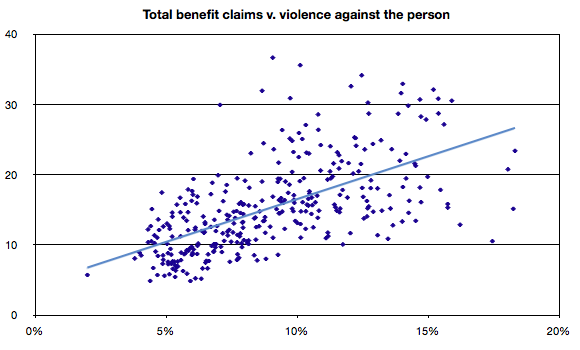I spent a good chunk of yesterday at the National Worklessness Advisory Panel (which reminded that I’d not done the usual post about JSA figures in Wandsworth). While I’m not going to go into most of the discussions there were some interesting topics raised. One which started me thinking was a discussion about the unintended consequences of local government finance – essentially that you are often effectively rewarded to fail. If you succeed as a council, for example, in reducing unemployment you may see yourself getting less grant from the government because you are less deprived, while other public services may see benefits.
Which set me thinking…

The graph is a comparison of the rate of working-age benefit claims against the recorded rate of violence against the person. It isn’t perfect, the data comes from two difference sources: benefit claims from Nomis are an average from the 2009 quarterly figures, crime from the Home Office’s RDS site and is for 2008-2009 and, because of local government reorganisation some areas couldn’t be compared.
However, I think it gives a clear picture of the relationship. And there’s probably no surprise that, generally the higher the rate of claims (and by extension unemployment) the higher the rate of crime. I will confess I was a little surprised that there wasn’t a tipping point at which recorded violent crime started shooting up. Instead it seems the range of broadens; it would be interesting to know why, for example, Knowsley has a relatively high rate of working age benefits (17.46%) but relatively low violent crime (11 crimes per 1,000 people) and whether that’s a consequence of effective policing and community safety work or something else.
As additionally evidence I would point to the increases in various crime types in Wandsworth, and elsewhere, during the recession.
While very few authorities fall bang on the trend line it rises at approximately 1.2 crimes per 1,000 for every 1% rise in claim rate. To give an example of what this means Wandsworth has a population of 282,000 (according to the Home Office, at least) so a 1% reduction in claim rate could be expected to result in 338 fewer violent crimes in a year if we followed the average trend. Perhaps not that many, but when you consider the costs of those crimes in police time, hopefully court time (processing the offender) and potentially hospital treatment (for the victim) it’s easy to see the that the impact on taxpayers’ money very quickly adds up.
Of course, Wandsworth is mature enough to recognise that the benefits of lower unemployment outweigh the potential loses in grants, but it is an interesting example of the inter-relationship of public services and something that every public service needs to consider carefully while we face the consequences of a huge deficit.
(Given my occasional bleatings about open data, if you are interested feel free to download the data I used to produce the chart and let me know if I’ve got it totally wrong. While I’m confident of the basic premise I caveat it all with the fact that I am not a statistician, and this is a result of procrastination and far too much coffee today.)